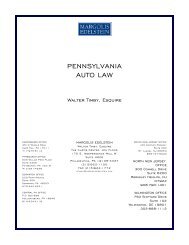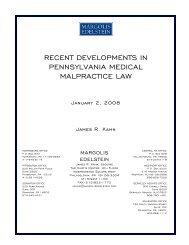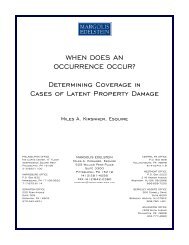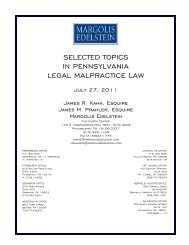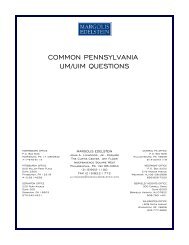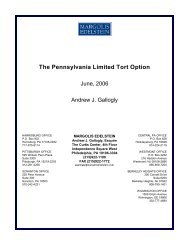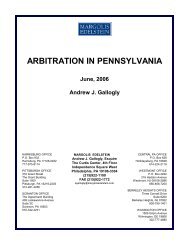Commercial General Liability Coverage Exclusions Under
Commercial General Liability Coverage Exclusions Under
Commercial General Liability Coverage Exclusions Under
You also want an ePaper? Increase the reach of your titles
YUMPU automatically turns print PDFs into web optimized ePapers that Google loves.
the assailant’s insurer by omitting facts, or by describing the insured’s conduct in a more benign way<br />
than the actual facts would warrant. Complaints in such cases will frequently indicate that the<br />
insured assailant merely acted negligently or recklessly in striking the plaintiff with a baseball bat<br />
or in shooting his victim several times in the head. Complaints have also gone so far as to allege that<br />
the insured was intoxicated and unable to formulate an intent to injure the plaintiff, or that the<br />
insured mistakenly believed that his beating of the plaintiff was necessary in self-defense.<br />
Although it is the complaint which initially determines an insurer’s defense obligations under<br />
Pennsylvania law, it is the factual allegations of the pleading which are controlling, not the legal<br />
labels or conclusions which accompany them. Thus, our courts have repeatedly recognized that mere<br />
allegations of negligence in a complaint are not sufficient to trigger a duty to defend where the<br />
factual allegations of the pleading clearly indicate that there is no potential coverage under the<br />
policy. See, e.g., Germantown Ins. Co. v. Martin, 595 A.2d 699 (Pa.Super. 1989), (no duty to defend<br />
when insured allegedly went to his former girlfriend’s home with an automatic weapon, shot and<br />
killed her new boyfriend and injured a boarder by shooting him four times in the chest, despite<br />
allegations of mere negligence); Erie Insurance Exchange v. Fidler, 808 A.2d 587 (Pa.Super. 2002),<br />
(holding that insured’s actions in throwing fellow student against a wall fell within scope of<br />
intentional injury exclusion, even though his actions were merely characterized as negligent in the<br />
complaint).<br />
b. Contractual <strong>Liability</strong><br />
“Bodily injury” or “property damage” for which the insured is obligated to pay damages by<br />
reason of the assumption of liability in a written contract or agreement. This exclusion does<br />
not apply to liability for damages:<br />
(1) That the insured would have in the absence of the contract or agreement; or<br />
(2) Assumed in a contract or agreement that is an “insured contract”, provided the<br />
“bodily injury” or “property damage”occurs subsequent to the execution of the<br />
contract or agreement ....<br />
• This should not be mistaken for an exclusion of coverage with respect to breach of contract<br />
claims in general, but instead applies only to indemnification agreements under which, to use the<br />
language of the exclusion, an insured has “assumed” the tort liability of another party.<br />
See, e.g., Brooks v. Colton, 760 A.2d 393 (Pa.Super. 2000). As the concept is explained in the<br />
Fidelity, Casualty & Surety Bulletins, “the language of the exclusion of contractual liability<br />
coverage is concerned only with liability that is assumed (that is, liability incurred when one<br />
promises to indemnify or hold harmless another) and does not deal with liability that results from<br />
breach of contract.”<br />
4



